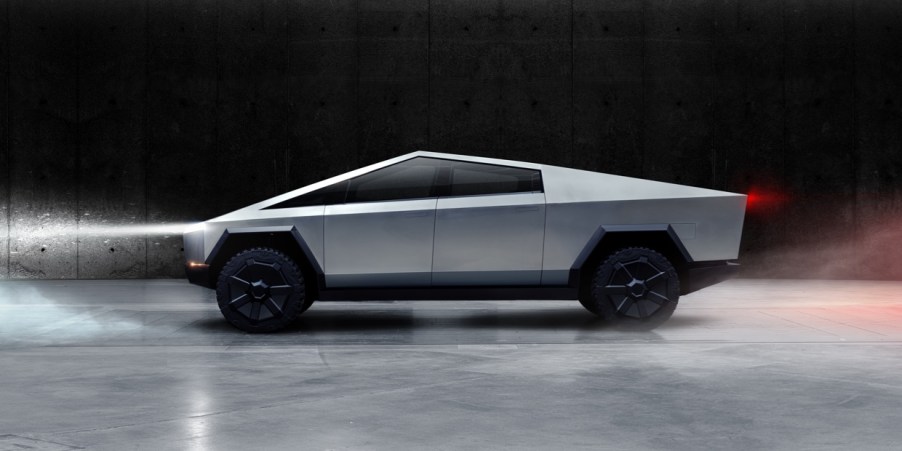
Tesla Cybertruck Won’t Actually Compete With the F-150
Although the cheapest Tesla Cybertruck is getting delayed, Tesla as a whole is still moving forward with Cybertruck production. The automaker is also moving forward with something else. Although Tesla rather pointedly set its truck against the Ford F-150 in an automotive tug-of-war, it turns out that the Cybertruck won’t, in fact, compete directly with the F-150.

Automotive News recently reported that in a letter Tesla submitted to the California Air and Resources Board, the automaker expected the Cybertruck to “very likely qualify as a ‘Class 2b-3 medium-duty vehicle.’” This is the same class that Ford’s Super-Duty, Ram’s 2500/3500HD, and GM’s 2500/3500HD trucks compete. And that has some significant implications for the Cybertruck.
Why the Tesla Cybertruck is being classified differently than the F-150

As both Automotive News and Autoblog explained, a truck’s class is determined by its gross vehicle weight rating. A GVWR of 8,501-10,000 lbs puts a truck above the ‘light-duty’ category, and into the ‘medium-duty’ category.

Although Tesla still hasn’t released the Cybertruck’s official weight, we suspected that the truck’s stainless steel body panels could make it rather heavy. Based on this letter, that appears to be the case. Autoblog also points out that the Cybertruck’s batteries also add a significant amount of weight, as they do for every electric vehicle.

By comparison, the 2020 Ford F-150 has a GVWR of 6070-7850 lbs, depending on the specific trim. But while Tesla claims the Cybertruck will be able to tow more than the F-150 can, classifying the electric pickup as medium-duty puts it at a disadvantage.
Why this might hurt the Cybertruck’s market performance

InsideEVs compared the Cybertruck’s specifications against other medium-duty, ICE trucks. And, as Doug DeMuro also pointed out in a recent video, the Cybertruck falls a little flat. While the Cybertruck can out-haul and out-tow most full-size, light-duty pickups, the same isn’t true for medium-duty ones.
The F-250, Ram 2500HD, and Silverado 2500HD all have a higher payload than the Cybertruck. Both gasoline and diesel versions. The same applies to towing capacity, although admittedly the gasoline Silverado 2500HD is only better by 500 lbs. But the problem’s bigger than that.

The Cybertruck can only tow 14,000 lbs in tri-motor AWD form. Drop down to the dual-motor version, and towing capacity decreases to 10,000 lbs. That’s more than a light-duty pickup, but way below any medium-duty pickups. What’s worse is that even the dual-motor Cybertruck is still more expensive than other medium-duty trucks. So, buyers will be paying more money for a truck that can’t haul or tow as much.

If Tesla was hoping to tempt Ford and Chevy owners into buying a Cybertruck, this isn’t going to help. But Tesla may have other reasons for pursuing a Class 2b-3 classification.
Why Tesla may want the Cybertruck classified differently than the F-150: the EPA
In a Twitter thread with the Automotive News report’s author, several people have pointed out that medium-duty vehicles aren’t rated by the EPA.
That means, if the Cybertruck is classified as a medium-duty truck, the EPA won’t be able to verify Tesla’s range claims. Although, this wouldn’t be the first time an American automaker used loopholes to get around the EPA. Ford did it with the original F-150.
Why Tesla may want the Cybertruck classified differently than the F-150: safety

But the Cybertruck’s medium-duty classification also has potential safety implications. One of the major concerns automotive engineers have with the Cybertruck’s design is crash safety. Looking at the truck, there don’t appear to be any front crumple zones. And the current interior seems to lack airbags. Tesla’s letter may indicate that this could be intentional.
If the Cybertruck isn’t classified as a Class 2b, but a Class 3 truck, like the Bollinger B2, Tesla won’t have to perform crash tests or conform to normal airbag requirements. Such a classification would also let the Cybertruck circumvent certain rollover standards.
We’re not suggesting Tesla would deliberately sell an unsafe vehicle. And Tesla is merely expressing projected information—the letter itself says the Cybertruck isn’t in production yet. But classifying it as a medium-duty truck does more than remove it from competition with the F-150.


